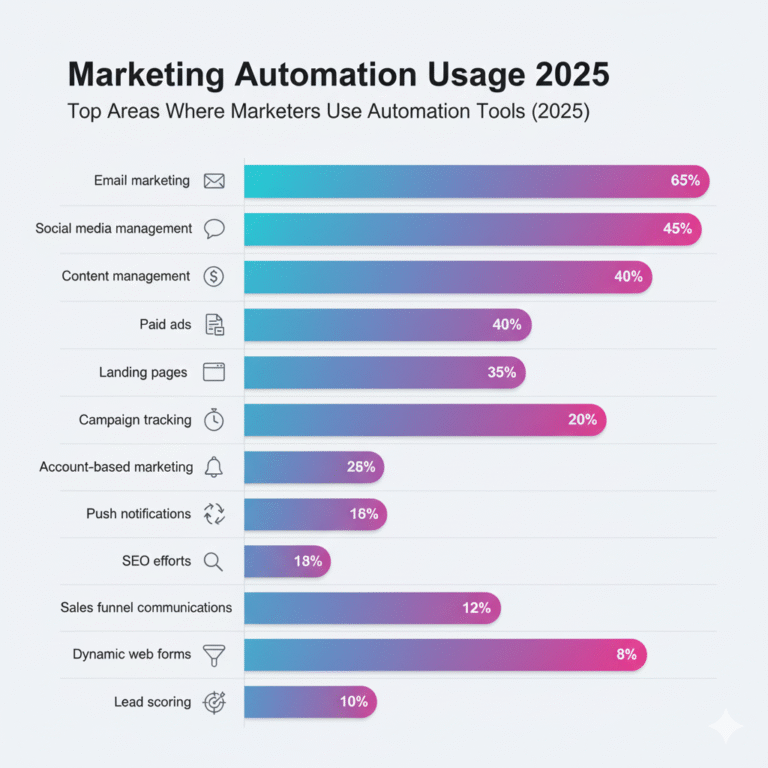In 2025, marketing automation is no longer optional, it’s essential. Customer expectations have soared: they want personalized, timely, relevant interactions across multiple channels. Meanwhile, the number of marketing channels has exploded, mar tech stacks are increasingly complex, and the pressure to deliver measurable ROI is relentless. In this environment, simply sending scheduled emails or batch-campaigns won’t cut it.
This article isn’t about generic theory. It’s about real hacks you can adopt now, designed for professional marketers in-house or in agencies who want to stay ahead. You’ll learn strategic context, tactical techniques, real-world examples, and clear next steps. For those who want to strengthen their skills even further, exploring business development courses online can be a great way to gain practical insights and accelerate career growth.
What’s Changed in Automation by 2025

To make sense of the hacks ahead, let’s first look at how marketing automation has evolved and why the tactics of years past are now insufficient.
- From batch to hyper-personalized, real-time sequences. Where marketers used to send bulk emails on fixed schedules, today’s platforms facilitate triggered workflows based on behavior, intent signals, and AI-driven timing.
- From siloed systems to unified mar tech stacks. In earlier eras many teams had email automation separate from CRM, separate from web analytics. Now, integration across systems (CRM, CDP, web behavior, mobile, chat) is the norm.
- From manual triggers to predictive automation. Instead of simply “if X then Y”, many organizations are using predictive analytics and machine-learning to forecast behavior and trigger workflows accordingly.
- From generic nurture to dynamic, adaptive customer journeys. Content no longer needs to be static by segment; it can change in real time based on device, location, prior purchases, channel interaction. These shifts are supported by the DMI guide, which highlights automation’s broadening scope and importance. In addition, guides like Adobe’s Definitive Guide elucidate the need for full-funnel, cross-channel orchestration and real-time behavior-based triggers. What this means: to stay ahead in 2025, you must think beyond “email blasts” and “scheduled sends”. Think dynamic, integrated, data-driven, agile. Now let’s dive into the hacks.
Hack #1 – Smart Data Triggers Over Calendar Sends
What it is:
Rather than relying on a fixed schedule (e.g., Tuesday at 10 am), set up automation triggers based on data: user behaviors, lifecycle stage, intent signals, profile changes.
Why it matters:
A trigger-based model aligns with how customers behave today they might view your pricing page twice in 24 h, then leave. You want to respond precisely when they’re engaged. Calendar-only sends risk being irrelevant or too late.
How to implement:
- Integrate your CRM with behavioral data (website visits, form fills, webinar attendance, app usage)
- Create micro-segments and build “if-then” logic: e.g., If visitor views pricing >2x in 24 h → Send personalized message + chat invite
- Map out key behavior-based triggers tied to your business model (e.g., broken cart, demo request after un-engaged period, high-intent page visit)
Mini case-example:
A SaaS company observed users visiting the pricing page twice within 24 h. They built a trigger: If (page views > 2) within 24 h → send email with product comparisons + offer chat support. The result: higher conversion rate from that cohort.
Actionable next step:
Audit your current automation workflows. Identify any that are purely calendar-based. For each, ask “Could this be triggered instead?” Map 3-5 behavior triggers you could implement in the next 30 days.
Hack #2 – Use AI to Personalize at Scale
What it is:
Many modern automation platforms embed AI/ML capabilities subject-line optimization, content block recommendations, optimal send-time prediction, dynamic content suggestions.
Why it matters:
Personalization at scale is infeasible manually. AI enables you to serve more relevant content, send at the right time, and adapt messaging on the fly.
How to implement:
- Select one area for a pilot: e.g., subject‐line generation or send-time optimizations
- Run a controlled A/B test: AI-generated vs manually written
- Create guardrails: brand tone, content boundaries, relevancy filters
- Monitor outputs for bias, non-relevance, or “creepy” personalization
Mini case-example:
An e-commerce brand used AI to vary recommended products in email content blocks based on browsing history + purchase data. They saw an uplift in average order value (AOV) of XX%.
Actionable next step:
Pick one format (email, SMS, push) and enable an AI feature (e.g., send-time optimizations). Track performance (open-rate, click-rate, conversion) and compare vs prior manual control.
Hack #3 – Automate Cross-Channel Orchestration
What it is:
Your automation workflow should span multiple channels email, SMS, push notifications, chatbots, webhooks, retargeting ads not just email alone.
Why it matters:
Customers interact across channels. A lead may click a social ad, visit your site, receive an SMS, and then watch a demo video. Automation that spans channels captures this journey and drives more coordinated actions. Additionally, optimizing your Google Business Profile ensures potential customers find accurate information quickly, enhancing engagement across all touchpoints.
How to implement:
- Map a journey across at least two channels (email + SMS, web + chat + push)
- Define channel-specific messages and timing logic
- Ensure your tech stack supports orchestration or integrates channel tools
- Example workflow (in bullets):
- User abandons cart on website → send SMS reminder after 30 min
- If no action in 12 h → send email with testimonial + product comparison
- 2 days later → retargeting ad on social/Google
Mini case-example:
A retail brand built a cross-channel automated campaign: web abandonment → SMS → email → ad retargeting. They improved recovery rate by YY%.
Actionable next step:
Choose one existing campaign (e.g., cart abandonment, demo request follow-up). Redesign it as a multi-channel workflow (min 2 channels) rather than email-only. Build and test.
Hack #4 – Real-Time Lead Scoring & Routing
What it is:
Rather than monthly or manual updates, implement real-time lead scoring based on user actions (profile fit, behaviors, intent) and route leads automatically into either sales or nurture workflows.
Why it matters:
Fast follow-up + proper prioritization increase conversion rates. Many leads slip through because scoring is outdated, or routing is manual.
How to implement:
- Define your scoring model: profile traits (company size, job role), actions (demo request, pricing page visit), intent signals (search query, chat transcript)
- Set thresholds: e.g., Score > 75 → sales alert; Score 30-75 → nurture; Score < 30 → educational nurture
- Build automation: when lead hits threshold, trigger routing (e.g., assign to sales rep, send SMS, add to nurture track)
Mini case-example:
A B2B company automated lead routing: when a prospect visited the pricing page AND downloaded a whitepaper AND company size > 500 → score >80 → immediate SMS + sales hand-off. Result: lead-response time dropped to under 5 minutes, and conversion rose by ZZ%.
Actionable next step:
Meet with your sales team to agree lead-qualification criteria. Build a scoring model with profile + behavior attributes. Implement real-time scoring and routing for one key lead-capture source (e.g., trade-show form, website demo request).
Hack #5 – Dynamic Content & Adaptive Journeys
What it is:
Workflows where content adapts based on the recipient’s characteristics segment, device, location, previous purchases, channel behavior. Journeys can split dynamically, not just by segment but by behavior.
Why it matters:
Static journeys lose relevancy. Today’s consumers expect the message to reflect who they are now, what they did, and where they are. Adaptive journeys deliver higher engagement and conversion.
How to implement:
- Use modular templates with content blocks tagged for conditional logic (e.g., region=”APAC”, purchase = yes/no)
- Map key decision-points and branch logic: e.g., if user is in India → show local offer; else global offer
- Test variants: one journey for high-value customers vs first-time visitors
Mini case-example:
A travel-brand automated email templates where the hero image changed based on subscriber’s past destination and time-zone. The personalized version increased open rate by 18%.
Actionable next step:
Select one automated journey (e.g., onboarding sequence). Audit content blocks and determine 2-3 variants (by region, by past purchase, by device). Build the logic and run A/B tests.
Hack #6 – Measure Outcomes & Close the Loop

What it is:
Automation isn’t just about “set-and-forget” sends. It’s about measurable outcomes: pipeline impact, conversions, lifetime value. Then using these metrics to optimize and iterate.
Why it matters:
Many teams stop at open-rates or click-rates, missing the bigger picture: Did automation contribute to revenue, customer lifetime value, retention? Without measurement and closed-loop optimization, automation becomes activity without insight.
How to implement:
- Define KPI metrics for your automation workflows (e.g., conversion rate from nurture, average order value uplift, time-to-sale)
- Set up automated dashboards/alerts: if conversion < X% → trigger review
- Automate A/B-tests and track performance. Use learning to refine workflows.
Mini case-example:
A marketing team created a report that automatically refreshed weekly and flagged nurture workflows with conversion <2%. A flagged workflow triggered a review meeting, adjustments were made, and performance improved.
Actionable next step:
Audit your current reporting: which automated workflows have outcome-tracking to revenue or value? Choose 3-5 key metrics for your automation efforts and build automated reporting/alerting for them.
Hack #7 – Governance, Compliance & Ethical Automation
What it is:
With growing data privacy concerns, AI ethics and customer trust are major issues in 2025. Automation needs proper governance: data, consent, transparency, bias mitigation.
Why it matters:
Customers are increasingly sensitive to how their data is used and automated interactions can feel intrusive or “creepy” if done poorly. Regulation (GDPR, local data-protection laws) and AI ethics frameworks demand proper oversight.
How to implement:
- Maintain robust consent records and ensure data usage aligns with declared purposes
- Ensure transparency: when using AI for personalization, avoid “we know too much” interactions
- Audit workflows regularly for bias or unfair targeting
- Develop internal governance: assign ownership of automation processes, define acceptable AI-use cases, document decision-logic
Mini case-example:
A subscription business paused a hyper-targeted ad triggered by inbound support queries because users felt spied-on. They redesigned the workflow with opt-in prompts and clearer messaging.
Actionable next step:
Review your automation workflows for consent and transparency. Are you using personal data in ways users expect? Audit your AI-driven content for bias or negative emotional response. Draft a governance checklist for your next automation rollout.
Conclusion
In 2025, marketing automation is no longer simply “set it and forget it.” It’s about dynamic orchestration, data-driven workflows, cross-channel integration, AI-powered personalization, and measurable ROI. The hacks above show how you can level up from generic automation to next-level strategic execution. If you’re looking to master these modern strategies, consider enrolling in a digital marketing institute in Ahmedabad to gain hands-on expertise and stay ahead in the evolving marketing landscape.
30-60-90 Day Action Plan:
- 30 Days: Audit current automation workflows. Identify calendar-based sends, email-only campaigns, un-measured journeys.
- 60 Days: Implement two of the hacks: e.g., Smart Data Triggers + Cross-Channel Orchestration. Build and test one pilot.
- 90 Days: Measure outcomes. Scale successful workflows. Build governance and compliance frameworks. Refine models, branch logic, and AI-personalization.
Remember: automation is an ongoing evolution, not a one-time setup. Revisit your workflows, iterate, adapt as your data, audience and channels evolve.


